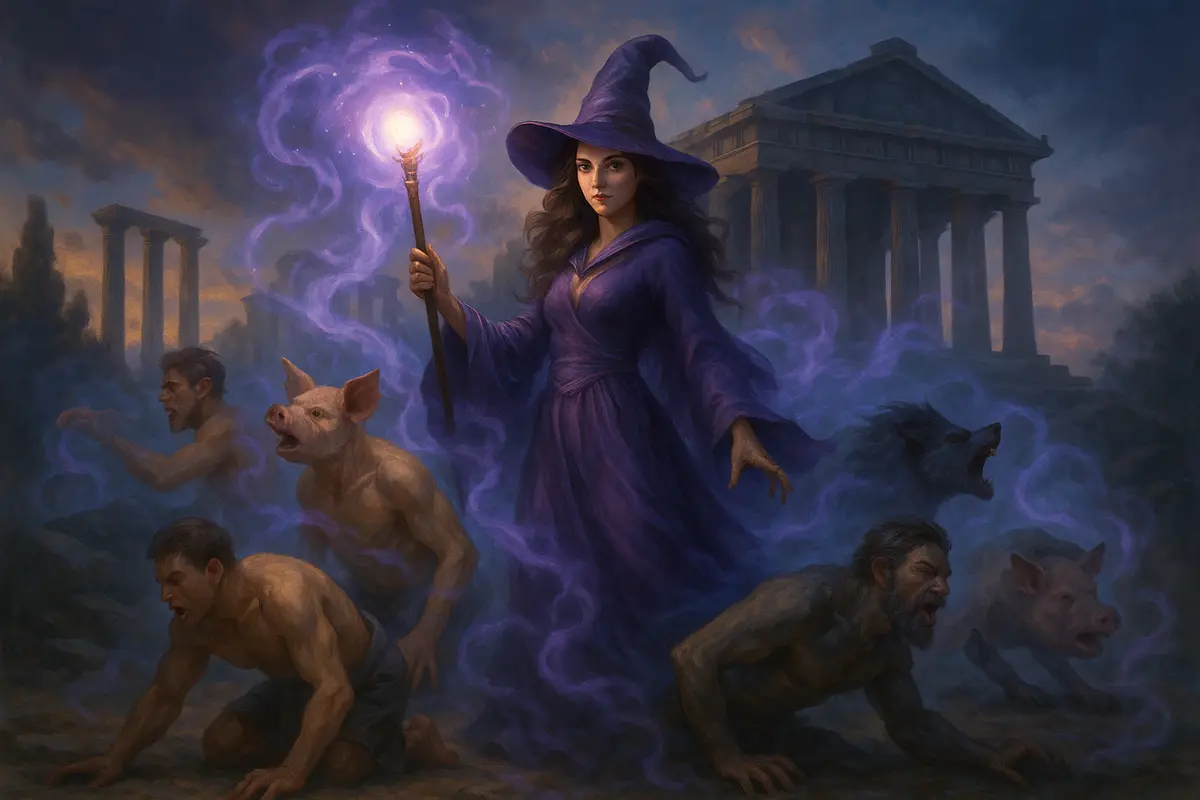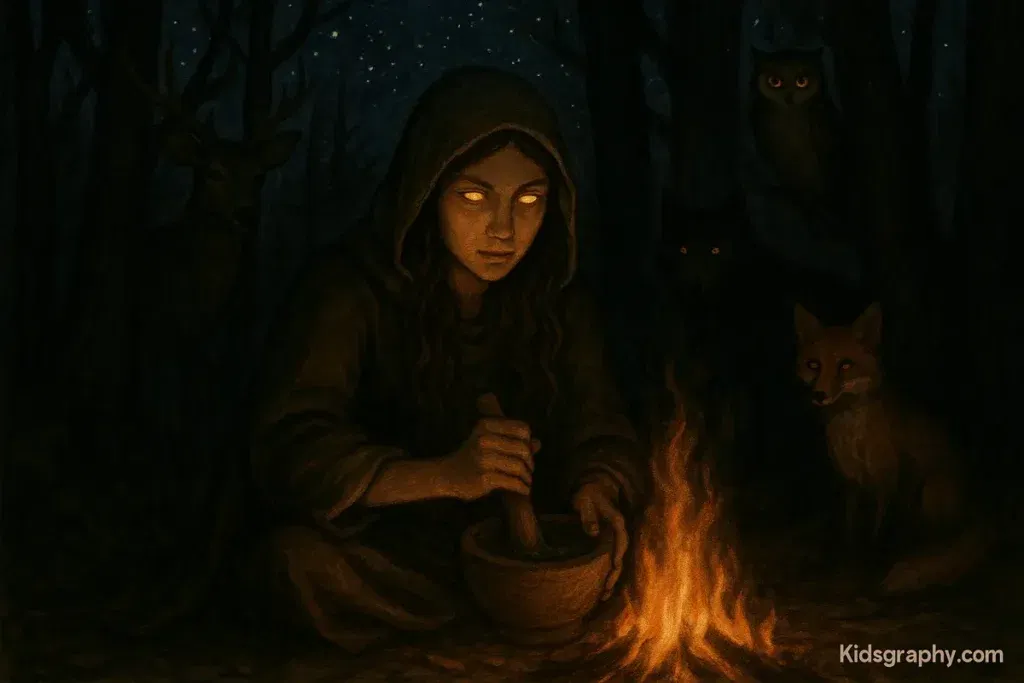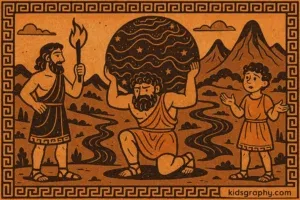In the magical and mysterious world of Greek mythology, few characters are as fascinating as Circe. She’s a powerful witch, a daughter of gods, and a woman who lives alone on a secret island. Her story is one of magic, transformation, and love—but also of loneliness and strength.
Many people know Circe because of her role in The Odyssey by Homer, where she meets the wandering hero Odysseus. But her story goes far beyond just that one moment. She is a figure of fear and wonder, respected even by the gods.
Who Is Circe in Greek Mythology?
Circe (pronounced “SIR-see”) is a sorceress or witch in ancient Greek myth. She is often called a minor goddess or a nymph, but her powers are anything but small.
She is the daughter of Helios, the Titan sun god, and Perse, an Oceanid (sea nymph). This means she is part divine, part magical, and deeply tied to both nature and the gods.
Circe lives alone on the island of Aiaia (also spelled Aeaea). Her home is filled with enchanted forests, wild animals, and magic. She is known for her knowledge of herbs and potions, and for one terrifying power—she can turn people into animals.
Turning Men into Beasts
One of the most famous parts of Circe’s story comes from The Odyssey. When Odysseus and his men arrive at her island after a long and dangerous journey, she welcomes them.
At first, they think they’re lucky. They’re tired, hungry, and finally see someone smiling at them with food and shelter. But Circe mixes a potion into their drink—and as soon as they drink it, they turn into pigs.
Circe doesn’t kill them. She keeps them in pens, feeding them like animals. When Odysseus finds out, he is furious. But before going to confront her, he’s visited by Hermes, the messenger god, who gives him a special herb called moly to protect him from her magic.
When Odysseus confronts Circe, her spell fails on him. He threatens her, and surprisingly, she surrenders. She turns his men back into humans, offers them food and rest, and even welcomes them to stay.
Odysseus and his crew stay with her for one full year.
A Witch’s Heart
Though many fear her, Circe is not evil. She is complex. She lives alone, not because she’s wicked, but because she is different. Even the gods don’t fully accept her. Her father, Helios, shines over the world. But Circe is in the shadows, working with roots and potions, finding her own path.
Some modern versions of the story describe her as misunderstood, not monstrous. She uses her powers for protection. The men she turns into pigs are often violent or cruel—she simply gives them the outside to match what’s inside.
In Homer’s tale, Circe falls in love with Odysseus. But she knows he cannot stay. He has a wife, Penelope, waiting at home in Ithaca. And though she has the power to stop him, she chooses not to. She helps him, guides him, and lets him go.
What Happens After Odysseus Leaves?
After Odysseus leaves, Circe’s story doesn’t end. In some versions of myth, she later has a child with Odysseus, named Telegonus. This son is raised away from his father—and years later, tragedy strikes.
This leads to one of the darker and lesser-known parts of greek mythology circe legends.
The Man Who Came Home to Find His Family Dead
There is a myth connected to Circe through her son. Telegonus, not knowing Odysseus is his father, sets out to find him. But during a fight, Telegonus accidentally kills Odysseus with a spear tipped in a stingray’s tail—one of Circe’s magical weapons.
Later, when Telegonus learns the truth, he brings Odysseus’s body and family back to Aiaia. In some myths, Penelope (Odysseus’s wife) and Telemachus (his son) come too.
That’s where the haunting line fits: “What person came back to find his whole family dead in Greek mythology in Circe?” It’s a mix of stories—sometimes the family dies, sometimes they live. But in every version, the ending is bittersweet. Lives are changed, families are broken or blended, and Circe remains at the center of it all.
Circe in Art and Epic Drawing
Circe has inspired artists for thousands of years. From Greek vases to Renaissance paintings to modern fantasy art, she is often shown as:
- A beautiful woman surrounded by animals like lions and wolves
- A witch stirring a glowing potion
- A lone figure on a cliff, staring out to sea
In digital drawings, she often appears with violet robes, golden eyes, and windswept hair, casting spells or brewing in a cauldron. The phrase “Circe epic drawing” often refers to these modern fan art styles—powerful, magical, and mysterious.
Circe in Modern Books
One of the most popular retellings of her story is the bestselling novel “Circe” by Madeline Miller. In this book, Circe tells her story in her own voice—from her childhood in Helios’s house to her lonely years on Aiaia, and her love for Odysseus.
The book shows Circe not just as a character in someone else’s journey, but as a powerful woman making her own choices. It blends old myths with new insights, turning her into a modern feminist icon.
Why Circe Still Matters
Circe is more than a witch. She’s a symbol of independence, wisdom, and the power to transform—both others and herself.
She reminds us that being different is not a curse. That knowledge, solitude, and magic don’t make someone evil. And that sometimes, the ones who live alone are the ones who see most clearly.
Circe in Greek mythology is a figure who shifts between fear and fascination. She turns men into animals—but she also turns pain into wisdom, and isolation into freedom.
More Stories: greek mythology
FAQ: Circe in Greek Mythology
Circe is a powerful sorceress from Greek mythology. She’s known for turning men into animals and appears in Homer’s Odyssey as a key figure in Odysseus’s journey.
Circe is often called a witch, but she’s technically a minor goddess. She’s the daughter of the sun god Helios and the sea nymph Perse.
Circe used her magic to transform disrespectful or dangerous men into animals. It was her way of protecting herself and her island.
Yes, Circe fell in love with Odysseus. Although she could have kept him, she let him leave after helping him on his journey.
Circe lived alone on a magical island called Aiaia. It was full of wild animals, enchanted forests, and hidden magic.
Read more: Noah’s Ark











